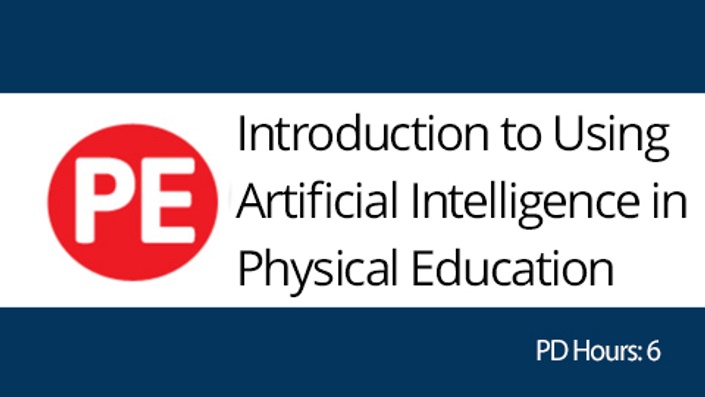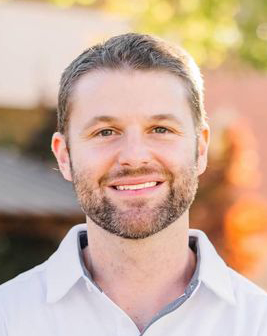
Introduction to Using Artificial Intelligence (AI) in Physical Education
Tips & Strategies for Using Chat GPT and Other AI tools for Lesson Planning
Welcome!
We are excited about your interest in taking this online course. This is a video based course that contains 8 modules. There are two multiple choice quizzes that you will be asked to complete during this module. One is located at end of Module 1 and then there is a culminating quiz that covers all material covered in the course. It is located in Module 8. Make sure you click Complete and Continue after completing each module. All videos are closed captioned but you can turn this feature off. In addition, you can take notes during the video instruction.
Below you will find a brief course description, the instructor's biography, and course FAQ's. We estimate that this course will take 6 hours to complete. Once you have completed, the LMS will automatically deliver you an email with the link to click to access your certificate. There is no graduate credit or CEU's available for completing this course.
We know you will find this course valuable and enjoyable. If you have any questions, please email us at "[email protected]".
Best of Luck!
PE Central and Human Kinetics Professional Development
Target Audience
This course is designed for physical education teachers at the elementary, middle, and high school levels who are interested in exploring the potential of artificial intelligence and language models in the context of physical education. Whether you're a seasoned educator or just starting, this course will provide you with a basic understanding of AI language models and their applications in physical education. Our instructor will guide you every step of the way as you discover new ways to engage your students and improve learning with cutting-edge technology. By the end of this course, you'll be able to recognize opportunities to integrate AI language models into your teaching practice and explore strategies to do so effectively.
Course Purpose
The purpose of this course is to provide physical educators with an introduction to AI language models and their applications in various fields, including physical education. Through this course, participants will learn how AI language models can be adapted and applied to improve student learning and engagement in physical education. Participants will also gain an understanding of prompt engineering in AI language models for physical education instruction, including how to design effective prompts that elicit desired responses from students. In addition, participants will learn how to access and use various free AI language model tools for physical education instruction. Finally, participants will apply AI language models to tasks such as backward design, assessment, scope and sequence, curriculum development, lesson planning, and email writing to save time and effort while maintaining high-quality instruction. By the end of this course, physical educators will be equipped with the knowledge and skills needed to integrate AI language models into their teaching practice effectively.
Course Description
Are you curious about how artificial intelligence and language models can revolutionize your physical education teaching practice? In this self-paced online course, we'll explore the exciting possibilities of AI language models in physical education. You'll learn about the basics of AI language models, including natural language processing and machine learning, and their applications in other fields. We'll then dive into how these technologies can be adapted for use in physical education to improve student engagement and learning outcomes.
Through practical examples and activities, you'll discover how AI language models can help you with a range of tasks, such as backward design, assessment, scope and sequence, curriculum development, lesson planning, and even writing emails more efficiently. You'll learn how AI language models can help you personalize instruction for individual students based on their unique needs and abilities. You'll also explore how they can provide feedback on student progress more effectively than traditional methods.
Throughout the course, our instructor will guide you through a series of hands-on exercises designed to help you integrate AI language models into your teaching practice seamlessly. By the end of the course, you'll have a solid understanding of how AI language models work in physical education settings and be equipped with practical strategies for using them effectively in your own teaching practice.
Course Objectives
On completion of this course, physical educators will be able:
- Understand the basics of AI language models and their applications in various fields.
- Identify how AI language models can be adapted in physical education to improve student learning and engagement.
- Understand the potential drawback and issues related to using AI Language Models.
- Understand prompt engineering in AI language models for physical education instruction, including how to design effective prompts that elicit desired responses.
- Learn how to access and use various free AI language model tools for physical education instruction.
- Apply AI language models to tasks such as backward design, assessment, scope and sequence, curriculum development, lesson planning, and email writing.
- Understand how to personalize instruction for individual students using AI language models based on their unique needs and abilities.
- Provide feedback on student progress more effectively using AI language models than traditional methods.
- Develop strategies for continuous improvement of teaching practice through the ongoing use of AI language models.
- Communicate the benefits of using AI language models in physical education teaching practice to colleagues and stakeholders.
- Integrate AI language models into teaching practice seamlessly to save time and effort while maintaining high-quality instruction.
Standards
This course addresses the following SHAPE America National Standards for K-12 Physical Education (2014).
- Standard 1. The physically literate individual demonstrates competency in a variety of motor skills and movement patterns.
- Standard 2. The physically literate individual applies knowledge of concepts, principles, strategies and tactics related to movement and performance.
- Standard 3. The physically literate individual demonstrates the knowledge and skills to achieve and maintain a health-enhancing level of physical activity and fitness.
- Standard 4. The physically literate individual exhibits responsible personal and social behavior that respects self and others.
- Standard 5. The physically literate individual recognizes the value of physical activity for health, enjoyment, challenge, self-expression and/or social interaction.
All module graphics: © Collin Brooks via Canva.com.
Your Instructor

Dr. Collin Brooks is an experienced, National Board Certified, and award-winning physical education teacher, blogger, podcaster, and presenter who currently serves as an assistant professor of Health and Physical Education at the University of West Georgia. Collin has presented and keynoted at the state and national level and is a co-creator of the #PhysEdSummit, an international online physical education conference. He has an impactful presence within the physical education online community and also has served on the SHAPE America Board of Directors. Collin is passionate about student-driven quality physical education, using technology to enhance learning in physical education, and helping physical education teachers improve their practices.
Check out Frequently Asked Questions Here!